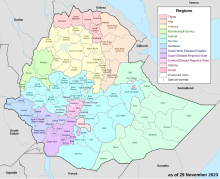North Shewa Zone (Oromia)

North Shewa (Amharic: ሰሜን ሸዋ; Afaan Oromo: Shawaa Kaabaa) is one of the Zones of the Ethiopia. North Shewa takes its name from the kingdom or former province of Shewa. North Shewa is bordered on the south by Oromia Special Zone Surrounding Addis Ababa, on the southwest by West Shewa, on the north by the Amhara Region, and on the southeast by East Shewa. Towns and cities in North Shewa include Debre Libanos, Fiche and Gerba Guracha.
Demographics

Based on the 2007 Census conducted by the Central Statistical Agency of Ethiopia (CSA), this Zone has a total population of 1,431,305, of whom 717,552 are men and 713,753 women; with an area of 10,322.48 square kilometers, North Shewa has a population density of 138.66. While 146,758 or 10.25% are urban inhabitants, a further 9 individuals are pastoralists. A total of 314,089 households were counted in this Zone, which results in an average of 4.56 persons to a household, and 303,609 housing units. The largest ethnic group reported in North Shewa was Oromo (84.33%) and followed by Amhara (14.99%); all other ethnic groups made up 0.68% of the population. Oromiffa was spoken as a first language by 82.85% and 16.73% spoke Amharic; the remaining 0.42% spoke all other primary languages reported. The majority of the inhabitants professed Ethiopian Orthodox Christianity, with 92.43% of the population having reported they practiced that belief, while 5.34% of the population were Muslim and 1.61% of the population professed Protestantism.[1]
The 1994 national census reported a total population for this Zone of 1,157,978 in 243,161 households, of whom 576,890 were men and 581,088 women; 86,289 or 7.45% of its population were urban dwellers at the time. The largest ethnic group reported in North Shewa was Oromo (59.53%), while Amhara account (39.81%); all other ethnic groups made up 0.66% of the population. Oromiffa was spoken as a first language by 59.41%, and 40.42% spoke Amharic; the remaining 0.17% spoke all other primary languages reported. The majority of the inhabitants professed Ethiopian Orthodox Christianity, with 94.04% of the population reporting as practicing that belief, while 5.03% of the population said they were Muslim.[2]
According to a May 24, 2004 World Bank memorandum, 7% of the inhabitants of North Shewa have access to electricity, this zone has a road density of 55.0 kilometers per 1000 square kilometers (compared to the national average of 30 kilometers),[3] the average rural household has 1.1 hectare of land (compared to the national average of 1.01 hectare of land and an average of 1.14 for the Oromia Region)[4] and the equivalent of 0.8 heads of livestock. 14.9% of the population is in non-farm related jobs, compared to the national average of 25% and a regional average of 24%. 62% of all eligible children are enrolled in primary school, and 12% in secondary schools. 41% of the zone is exposed to malaria, and none to tsetse fly. The memorandum gave this zone a drought risk rating of 510.[5]
References
- ^ Census 2007 Tables: Oromia Region, Tables 2.1, 2.4, 2.5, 3.1, 3.2 and 3.4.
- ^ 1994 Population and Housing Census of Ethiopia: Results for Oromia Region, Vol. 1, part 1, Tables 2.1, 2.7, 2.12, 2.15, 2.17 (accessed 6 April 2009)
- ^ "Ethiopia - Second Road Sector Development Program Project", p.3 (World Bank Project Appraisal Document, published 19 May 2003)
- ^ Comparative national and regional figures comes from another World Bank publication, Klaus Deininger et al. "Tenure Security and Land Related Investment", WP-2991 Archived 2007-03-10 at the Wayback Machine (accessed 23 March 2006).
- ^ World Bank, Four Ethiopias: A Regional Characterization (accessed 23 March 2006).
9°30′N 38°40′E / 9.500°N 38.667°E
Template:Zones of the Oromia Region Template:Woredas of the Semien Shewa Zone, Oromo
